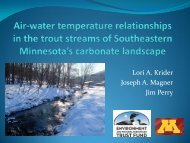Great Lakes Regional Water Program Great Lakes Regional Water
Great Lakes Regional Water Program Great Lakes Regional Water
Great Lakes Regional Water Program Great Lakes Regional Water
You also want an ePaper? Increase the reach of your titles
YUMPU automatically turns print PDFs into web optimized ePapers that Google loves.
ACTION:<br />
Using <strong>Regional</strong> Section 406 funding, the two states, along with Illinois, created a training and education program that<br />
met the needs of applicators in all three states. A three-stage program was created that combines existing educational<br />
materials (Livestock and Poultry Environmental Stewardship curriculum), adapted for this audience’s needs, with new<br />
material that meets the educational needs of the field-level employee. Project goals are to insure that:<br />
7 Every applicator knows how to prevent manure spills, and the steps<br />
to take in the event one does occur<br />
7 Every applicator is knowledgeable of their state's regulations<br />
7 Basic, common sense can be demonstrated as it relates to<br />
manure application<br />
7 Advanced training and testing in odor control, ethics, and equipment<br />
calibration is provided for crew supervisors and business owners<br />
7 An opportunity exists for the most advanced firms to demonstrate<br />
their commitment to proper application and environmental protection<br />
Animal waste from farms and livestock/poultry and dairy production operations<br />
can severely threaten water quality if nropriately managing animal wast<br />
OUTCOMES/IMPACTS:<br />
The original project objective was to reduce manure spills and increase nutrient management plan implementation.<br />
Spill numbers have increased in each of the three states, but regulatory staff attribute this to the fact that both for-hire<br />
applicators and farmers are now more willing to report spills than they were in the past. The telling fact is that in Wisconsin,<br />
more than 10% of the reported spills from July 2004 to March 2005 involved a for-hire applicator. Of those, two involved a<br />
trained individual – one was a runoff event (rain after application), the other was an unpreventable mechanical failure.<br />
Market-based incentives created by the insurance industry have been the key to the program’s adoption. The opportunity<br />
to save $500-$8,000 per year gives small businesses a powerful incentive for implementation. The insurance underwriters<br />
and agents have also taken responsibility for the annual audits of Level 3 Certification, saving an average of $500 in agency<br />
expense each year for each firm in the program. In Wisconsin, the program has prevented the state from implementing<br />
a regulatory program for the industry. Taxpayer savings are estimated at $80,000 annually based on the cost of similar<br />
programs in Iowa and Minnesota. In addition, within-industry partnerships multiplied as a result of this project, increasing<br />
learning and resource sharing, which is particularly beneficial to smaller businesses.<br />
A recently funded Ohio component of this project has led to the formation of a new Ohio nutrient applicator’s association.<br />
About 100 nutrient applicators have been trained in Best Management Practices for Liquid Manure Application there.<br />
9

















